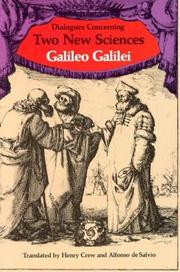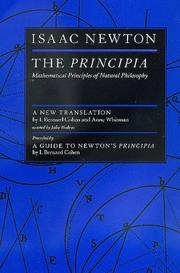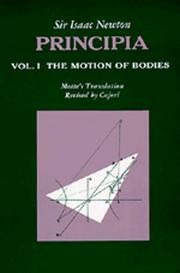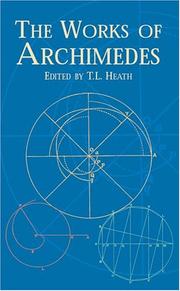| Listing 1 - 10 of 10 |
Sort by
|
Digital
Year: 1733 Publisher: London Printed for J. Senex ... [et al.]
Abstract | Keywords | Export | Availability | Bookmark
 Loading...
Loading...Choose an application
- Reference Manager
- EndNote
- RefWorks (Direct export to RefWorks)

ISBN: 0486600998 9780486600994 Year: 1954 Publisher: New York, N.Y.: Dover,
Abstract | Keywords | Export | Availability | Bookmark
 Loading...
Loading...Choose an application
- Reference Manager
- EndNote
- RefWorks (Direct export to RefWorks)
Mechanics --- Physics --- Mécanique --- Physique --- Early works to 1800 --- Ouvrages avant 1800 --- Mechanics. --- Early works to 1800. --- Mécanique --- Mechanics - Early works to 1800 --- Physics - Early works to 1800

ISBN: 0520088166 0520088174 9780520088177 Year: 1999 Publisher: Berkeley University of California press
Abstract | Keywords | Export | Availability | Bookmark
 Loading...
Loading...Choose an application
- Reference Manager
- EndNote
- RefWorks (Direct export to RefWorks)
In his monumental 1687 work 'Philosophiae Naturalis Principia Mathematica', known familiarly as the 'Principia', Isaac Newton laid out in mathematical terms the principles of time, force, and motion that have guided the development of modern physical science. Even after more than three centuries and the revolutions of Einsteinian relativity and quantum mechanics, Newtonian physics continues to account for many of the phenomena of the observed world, and Newtonian celestial dynamics is used to determine the orbits of our space vehicles. This completely new translation, the first in 270 years, is based on the third (1726) edition, the final revised version approved by Newtonit includes extracts from the earlier editions, corrects errors found in earlier versions, and replaces archaic English with contemporary prose and up-to-date mathematical forms. Newton's principles describe acceleration, deceleration, and inertial movementfluid dynamicsand the motions of the earth, moon, planets, and comets. A great work in itself, the 'Principia' also revolutionized the methods of scientific investigation. It set forth the fundamental three laws of motion and the law of universal gravity, the physical principles that account for the Copernican system of the world as emended by Kepler, thus effectively ending controversy concerning the Copernican planetary system. The illuminating Guide to the 'Principia' by I. Bernard Cohen, along with his and Anne Whitman's translation, will make this preeminent work truly accessible for today's scientists, scholars, and students.
Mechanics --- Celestial mechanics --- Mécanique --- Mécanique céleste --- Early works to 1800. --- Ouvrages avant 1800 --- Newton, Isaac, --- -Celestial mechanics --- -Gravitational astronomy --- Mechanics, Celestial --- Astrophysics --- Classical mechanics --- Newtonian mechanics --- Physics --- Dynamics --- Quantum theory --- Early works to 1800 --- Newton, Isaac Sir --- -Early works to 1800 --- Mécanique --- Mécanique céleste --- Mechanics - Early works to 1800 --- Celestial mechanics - Early works to 1800
Book
ISBN: 0521334993 9780521334990 Year: 1989 Publisher: Cambridge Cambridge University press
Abstract | Keywords | Export | Availability | Bookmark
 Loading...
Loading...Choose an application
- Reference Manager
- EndNote
- RefWorks (Direct export to RefWorks)
Mechanics --- Celestial mechanics --- Early works to 1800 --- Manuscripts --- Facsimiles --- -Celestial mechanics --- -Mechanics --- -Classical mechanics --- Newtonian mechanics --- Physics --- Dynamics --- Quantum theory --- Gravitational astronomy --- Mechanics, Celestial --- Astrophysics --- -Facsimiles --- -Early works to 1800 --- Classical mechanics --- Manuscripts&delete& --- Mechanics - Early works to 1800 --- Celestial mechanics - Manuscripts - Facsimiles --- Mechanics - Manuscripts - Facsimiles --- Celestial mechanics - Early works to 1800
Book
ISBN: 0521640660 9780521640664 Year: 1999 Publisher: Cambridge : Cambridge university press,
Abstract | Keywords | Export | Availability | Bookmark
 Loading...
Loading...Choose an application
- Reference Manager
- EndNote
- RefWorks (Direct export to RefWorks)
Mechanics --- Celestial mechanics --- Early works to 1800. --- Gravitational astronomy --- Hemelmechanica --- Mechanica [Hemel] --- Mechanics [Celestial ] --- Mécanique céleste --- -Mechanics --- -Classical mechanics --- Newtonian mechanics --- Physics --- Dynamics --- Quantum theory --- Mechanics, Celestial --- Astrophysics --- Early works to 1800 --- Newton, Isaac Sir --- Newton, Isaac, --- Newton, Isaac, Sir --- Mechanics - Early works to 1800 --- Celestial mechanics - Early works to 1800
Book
ISBN: 9516530109 9789516530102 Year: 1974 Volume: 50 Publisher: Helsinki : Societas Scientiarum Fennica,
Abstract | Keywords | Export | Availability | Bookmark
 Loading...
Loading...Choose an application
- Reference Manager
- EndNote
- RefWorks (Direct export to RefWorks)
Celestial mechanics --- Eudoxus, of Cnidus --- Early works to 1800 --- -Eudoxus, of Cnidus --- Gravitational astronomy --- Mechanics, Celestial --- Astrophysics --- Mechanics --- Celestial mechanics - Early works to 1800 --- Eudoxus, of Cnidus. --- Early works to 1800.

ISBN: 0520009282 9780520009288 Year: 1962 Publisher: Berkeley University of California Press
Abstract | Keywords | Export | Availability | Bookmark
 Loading...
Loading...Choose an application
- Reference Manager
- EndNote
- RefWorks (Direct export to RefWorks)
Celestial mechanics --- Mécanique céleste --- Early works to 1800 --- Ouvrages avant 1800 --- Mechanics --- Mathematics --- Mathematic --- Gravitational astronomy --- Mechanics, Celestial --- Astrophysics --- Mécanique --- Newton, Isaac --- Mechanics - Early works to 1800
Book
ISBN: 3515085327 9783515085328 Year: 2004 Volume: 182. Publisher: Stuttgart Steiner
Abstract | Keywords | Export | Availability | Bookmark
 Loading...
Loading...Choose an application
- Reference Manager
- EndNote
- RefWorks (Direct export to RefWorks)
Military engineering --- Siege warfare --- Mechanics --- Génie militaire --- Guerre de siège --- Mécanique --- Early works to 1800. --- Early works to 1800 --- Ouvrages avant 1800 --- Athenaeus, --- 600 --- Technology --- Génie militaire --- Guerre de siège --- Mécanique --- Mechanics - Early works to 1800 --- Athenaeus, - active 2nd century BC? - Peri mēchanēmatōn

ISBN: 0486420841 0486154394 Year: 2013 Publisher: : Dover Publications,
Abstract | Keywords | Export | Availability | Bookmark
 Loading...
Loading...Choose an application
- Reference Manager
- EndNote
- RefWorks (Direct export to RefWorks)
The complete works of antiquity's great geometer appear here in a highly accessible English translation by a distinguished scholar. Remarkable for his range of thought and his mastery of treatment, Archimedes addressed such topics as the famous problems of the ratio of the areas of a cylinder and an inscribed sphere; the measurement of a circle; the properties of conoids, spheroids, and spirals; and the quadrature of the parabola. This edition offers an informative introduction with many valuable insights into the ancient mathematician's life and thought as well as the views of his contemporar
Mathematics, Greek --- Geometry --- Mechanics --- Early works to 1800 --- Geometry -- Early works to 1800. --- Mechanics -- Early works to 1800. --- Mathematics, Greek. --- Mathematics --- Physical Sciences & Mathematics --- Mathematics - General --- Classical mechanics --- Newtonian mechanics --- Physics --- Dynamics --- Quantum theory --- Mathématiques grecques --- Archimedes. --- Archimède --- Contribution à la géométrie --- Contribution à la mécanique --- Mathématiques grecques. --- Contribution à la géométrie. --- Contribution à la mécanique.
Book
ISBN: 9780521115490 0521115493 Year: 2011 Volume: 47 Publisher: New York: Cambridge university press,
Abstract | Keywords | Export | Availability | Bookmark
 Loading...
Loading...Choose an application
- Reference Manager
- EndNote
- RefWorks (Direct export to RefWorks)
"In this forgotten treatise, preserved largely in medieval translations into Arabic and Latin, the greatest medical scientist of antiquity investigates the relationship between conscious and unconscious movements. He looks at the structure of the tongue and the oesophagus, and asks why mental perceptions can have physical effects on the body. Some of his questions still trouble modern scientists, although they would not accept most of his answers. The extensive Introduction and Commentary explain the medical background for non-medical specialists, and discuss the place of this treatise and of anatomy in medieval medicine down to Leonardo da Vinci. As well as being the first English translation of this important work, this is also the first comparative study of medieval translations of the same ancient text, and is based on new editions and collations of all three. The Commentary pays special attention to the linguistic elements involved in making these translations"--Provided by publisher.
Kinesiology --- Human mechanics --- Human anatomy --- Medicine, Medieval. --- Cinésiologie --- Mécanique humaine --- Anatomie humaine --- Médecine médiévale --- Early works to 1800 --- Early works to 1800. --- Ouvrages avant 1800 --- Medicine, Greek and Roman --- Cinésiologie --- Mécanique humaine --- Médecine médiévale --- Medicine, Medieval --- Medieval medicine --- Cinesiology --- Motor ability --- Body mechanics, Human --- Human biomechanics --- Human movements --- Movements, Human --- Animal mechanics --- Human physiology --- Physical anthropology --- Human mechanics - Early works to 1800 --- Kinesiology - Early works to 1800 --- Human anatomy - Early works to 1800
| Listing 1 - 10 of 10 |
Sort by
|

 Search
Search Feedback
Feedback About UniCat
About UniCat  Help
Help News
News